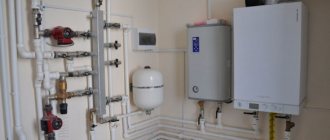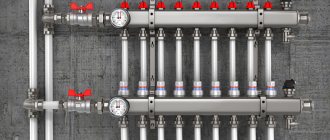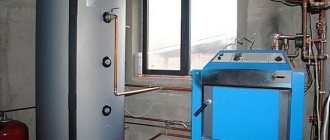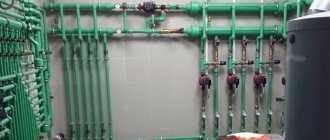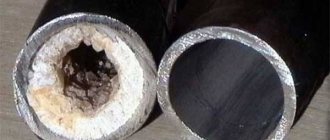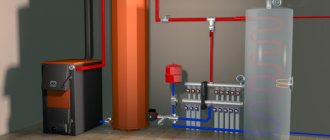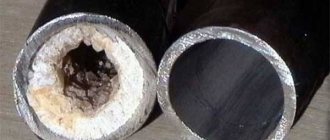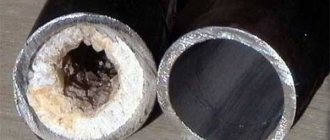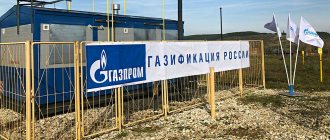- Functions of devices used for piping a gas boiler
Two-pipe heating scheme for a house with a hydraulic arrow and collectors, designed for the ground floor and 1st floor
Installation and connection of the boiler
Now let's talk about how to install gas heating in a private house. To install a gas boiler, you need to allocate a separate room, which has the following requirements:
- fire resistance limit of enclosing structures is not less than 45 minutes;
- ceiling height – 2.5 m;
- unobstructed access to the boiler;
- the presence of a separate exit to the street and a window opening;
- presence of a gas analyzer.
Installation of a gas heating boiler
Before we talk about installing gas heating, it’s worth understanding the structure of the boiler. Installation of a gas heating boiler in a private house:
- Rectangular gas burner with nozzles for uniform flame distribution and efficient fuel combustion.
- The heat exchanger is a metal box with a built-in battery. A coolant circulates inside the pipes, which is heated by the heat released during gas combustion. In single-circuit boilers there is one heat exchanger, and in double-circuit devices there are two.
- A circulation pump is needed to regulate pressure in systems with forced circulation. This part is not available on all boilers.
- Expansion tank for temporary coolant removal.
- Automatic boiler control system.
- A device that is responsible for removing gas combustion products. In atmospheric units, this part is connected to the chimney, and in turbocharged boilers there is a double pipe with a built-in fan.
Installation of a floor-standing boiler
If the installation of gas heating is carried out using a floor-mounted boiler, then a solid base with a fireproof floor covering must be prepared. The walls around the device to a height of more than 10 cm must have a fire-resistant coating. The minimum distance of the gas burner from the wall is 1 m.
First, the unit is connected to the chimney, then connected to the heating system inside the house. A coarse filter is installed at the return inlet. Shut-off valves are installed on all pipelines leading to the boiler. The two-pipe device is connected to the cold water supply pipeline.
Installation of a wall-mounted boiler
Before installing a wall-type device, remove the plugs from it and wash the tubes inside with water pressure supplied under pressure. This is how debris that might have gotten in during assembly and transportation is removed from the device.
The unit should only be hung on a flat and solid wall on which a non-flammable gasket is installed. The device is mounted so that there is a gap of 45 mm from it to the wall surface. The boiler must be installed at a distance of at least 20 cm from other equipment. An outlet must be equipped nearby.
To fix the boiler, special strips are used, which are set according to the level. After this, the equipment is connected to the water supply. Filters are installed on the incoming water pipes. To connect the gas pipeline, a steel pipe with a paronite gasket is used.
https://youtube.com/watch?v=4FS6-0gf1_I
Connection to the water supply system
Work on connecting a gas boiler to a water supply is similar to connecting to a heating circuit. The only difference is that pipes and taps of a different diameter are used. And here you will also need a filter to purify the water. Remember, any debris that gets into the boiler can cause irreparable damage, so you shouldn’t skimp.
The main rule is that a connection error will be costly. The minimum is the creation of an emergency situation, the maximum is an explosion. The connection to the gas pipe must be made very carefully. Before starting, check everything again; caution in such a matter is the key to safety. Of course, you can connect to the gas pipeline yourself. But we strongly recommend turning to specialists. It won’t cost that much, but you will definitely be sure that everything is done in accordance with the standards and there will be no leaks. The first start-up of the boiler is also recommended to be carried out under the supervision of a specialist. The first launch can bring many surprises and reveal problems that you cannot correct on your own.
Installation of an autonomous heating system in an apartment step by step
Coordination of all planned alterations with the relevant organizations. Notifying neighbors that work is planned at a certain time. The time frame will need to be agreed upon in advance, since such repair work is always accompanied by loud noise. You don't want conflicts with your neighbors. If gas heating is planned, then a special chimney must be equipped in advance. If the device is electric, you will have to install a separate line of appropriate power in advance to power it. Where the heating device is installed, the floor finishing must be made of non-combustible material. According to the standards, a certain distance from walls and furnishings is provided. The next step will be to mark the boiler, pipes and radiators according to the prepared project. If the system operates with a gas boiler, you will need to install a gas flow meter. This is not required for electrical equipment. Buy and deliver the boiler to the installation site. While still in the store, check it for completeness, as well as for the absence of visible defects and damage. Even minor scratches on the body may indicate that the boiler was either transported incorrectly or was dropped by movers. And all this can lead to breakdowns that are not noticeable upon purchase and can only be discovered during operation. Installation of gas equipment
Particular attention should be paid to leveling the boiler horizontally and vertically; Only correct installation guarantees stable operation of such a heating device. Laying heating pipes according to the project diagram. As a rule, circuits with forced coolant circulation are used
Therefore, if a pump is not provided inside the gas boiler, then it will need to be purchased and installed. Boiler piping - connecting equipment to water supply and gas supply pipes. And also an exit to the chimney. Connecting heating radiators. If necessary, purchase and installation of new heating elements. Test launch of an autonomous heating system. It is necessary in order to find and eliminate possible leaks in joints, and check the performance of gas or electrical equipment, as well as the efficiency of the entire system.
An autonomous heating system is profitable and efficient. However, we should not forget that autonomous heating in an apartment with your own hands is an unsafe undertaking. Moreover, if you plan to use gas equipment, then only specialists should install it.
In general, we answered the question of whether it is possible to install autonomous heating in an apartment: not only is it possible, but it is often necessary. After all, utility bills are only growing every year, and heating bills are the highest.
Water heating
The use of water as a coolant for heating began at the end of the 18th century. The French engineer Bonneman created a heated incubator with natural circulation of liquid. In Russia, until 1917, only rich people and apartment buildings could afford such a system. The rest of the residents used a wood or coal stove for heating.
Now water or chemical liquids are the most common coolant in heating systems of both apartment buildings and private houses.
Water has the highest heat capacity among all known substances - 4.18 J/gK. Slowly heating up, it also slowly releases energy to the surrounding space. This is the most efficient heat accumulator that smoothes out temperature changes on a planetary scale.
Water or antifreeze, heated by a gas boiler, moves through pipes to heating devices, where they transfer heat to the surrounding space through radiation. The process involves the transfer of energy by convection between heated layers of air.
Heating systems with liquid coolant are distinguished by:
- long service life;
- possibility of using different types of fuel in universal boilers;
- long-term heat retention in the room when the water in the radiators cools;
- uniform heating of batteries;
- simple maintenance.
Disadvantages of water systems:
- installation of pipelines and radiators is quite labor-intensive;
- during interruptions in work in winter, the pipeline may be damaged;
- in open systems where water evaporates in expansion tanks, regular replenishment is required;
- prolonged presence of water causes corrosion of metal parts and the formation of insoluble sediment;
- When pressure drops, air pockets form.
Some deficiencies can be eliminated by using distilled water or antifreeze. This leads to increased operating costs, but protects against breakdowns and leaks.
Documents for the boiler
Let's say you have equipped the furnace room in compliance with all requirements. Are we buying a boiler? It is too early. First of all, check if the previous gas papers have been lost, and bring them out into the light of day:
- Gas supply contract if the boiler is a heating boiler. Subconsumers can only install hot water boilers.
- All documents for the gas meter. Any boiler cannot be installed without a meter. If it doesn’t exist yet, there’s nothing you can do, you need to install it and arrange it, but that’s a different topic.
Now you can buy a boiler. But, having bought it, it’s too early to install:
- The BTI needs to make changes to the registration certificate of the house. For privatized apartments - through the organization operating the house. In the new plan, a closet under the boiler should be shown, and clearly marked: “Furnace room” or “Boiler room”.
- Submit an application to the gas service for the project and specifications. The required documents also include a technical passport for the boiler, so it must already be purchased.
- Install the boiler (see next section), except for the gas system. This can be done while the gas workers are preparing the project, if the premises are approved.
- Call a specialist to make a gas connection.
- Submit an application to gas workers for commissioning.
- Wait for the gas service engineer to arrive, he will check everything, draw up a conclusion on suitability and give permission to open the gas shut-off valve to the boiler.
Two-pipe heating system for a 2-story house
Truly comfortable living conditions can only be achieved by installing a two-pipe heating system. Its design allows you to regulate the temperature in individual rooms and save energy resources.
How does a two-way circuit work?
Unlike a single-pipe circuit, a two-pipe circuit consists of a pair of lines with different purposes: one of them supplies coolant, the second returns it back. The radiators are connected not in series order, but in parallel. One circuit, with heated coolant, extends from the riser to the radiators of both floors, the second is mounted to the boiler outlet and is also distributed to both floors.
Radiators are equipped with thermostatic valves that allow you to set a comfortable temperature. If desired, you can reduce the heating intensity partially or completely block the flow of water into the device.
Some devices are fundamentally embedded in the return line, for example, a membrane tank that regulates pressure, a circulation pump and a safety valve are traditionally installed in front of the boiler
In modern 2-story houses, two-pipe structures are used, since they are much more efficient than single-pipe ones:
- reduce pressure loss;
- do not require a powerful pump;
- keep the coolant temperature the same for each radiator;
- allow you to use many different thermal devices within one system (for example, radiators, convectors and “warm floors”);
- make it possible to repair and replace parts without compromising overall functionality.
The main disadvantage is the difficulty of self-installation - during assembly, consultation and supervision of professionals is required.
Types of gas boilers
The wall-mounted version is more compact, but less powerful
Types of wall-mounted boilers for home heating
First of all, it is worth dividing gas heating equipment according to functionality: will it be used only for heating or also for preparing hot water for technical needs. If you plan to heat water, you need a double-circuit boiler; a single-circuit boiler only works for heating.
Wall-mounted gas boilers - a small cabinet that is fashionable to install in the kitchen
Next, you need to decide on the type of smoke exhaust. There are gas boilers with atmospheric chimneys and open combustion chambers, and there are those with turbocharged boilers (their combustion chamber is closed). Atmospheric ones require a good chimney and draft in it, oxygen for combustion comes from the room in which the unit is installed, therefore there must be an air flow channel and a working chimney (all this is checked when starting the system).
Types of combustion chambers
Boilers with forced draft (turbocharged) can be installed without a chimney. The boiler's smoke output through a coaxial pipe (also called a pipe in a pipe) can be discharged directly into the wall. In this case, smoke comes out through one pipe (pumped by the turbine), and combustion air enters through the second pipe directly into the combustion chamber.
This type of equipment is good for everyone, except that in winter the coaxial line becomes overgrown with frost, which impairs traction. If the draft is poor, the automatic system extinguishes the boiler so that combustion products do not enter the room. Switching on is possible only when traction is restored, that is, snow build-ups will have to be chipped or otherwise removed.
There is also a separate type of boilers - condensing boilers. They are characterized by very high efficiency due to the fact that heat is removed from the flue gases (vapors condense). But high efficiency is achieved only when operating in low-temperature mode - the coolant in the return pipeline should not have a temperature above +40°C. If the temperature is even lower, even better.
Condensing boilers are the most efficient
Such conditions are suitable for heating with water heated floors. So if you are planning such a gas heating of a private house - with heated floors, then a condensing boiler is what is required. It has few disadvantages - high price (compared to conventional ones) and caustic condensate, which places special demands on the quality of the chimney (made of good stainless steel).
Floor standing gas boilers
If you need more power, the wall-mounted option will not work - they have a maximum output of 40-50 kW. In this case, a floor-standing boiler is installed. Here they are of high power, and there are also models that can work in cascade. This way you can generally heat large areas.
Some of the floor-standing boilers can operate not only from main gas, but also from liquefied gas. Some can also work with liquid fuel. So these are quite convenient units. Their body is made of steel, and the heat exchanger can be steel or cast iron. Cast iron ones weigh and cost more, but have a longer service life - 10-15 years. Inside the housing there is a burner, automation and heat exchanger.
The structure of a floor-standing gas boiler
When choosing, you need to pay attention to the functionality of the automation. In addition to the standard set - monitoring the presence of gas, flame and draft, there are many more useful functions:
- maintaining the set temperature,
- possibility of programming modes by day or hour,
- compatible with room thermostats;
- adjusting the boiler operation to the weather,
- summer mode - work to heat water without heating;
- possibility of working in parallel with solar panels or other alternative heat sources, etc.
The wider the functionality of the automation, the more expensive the boiler and its maintenance
But many programs also allow you to save fuel, which is no less important. In general, the choice is yours.
Stages of installing a gas heating system in a private house
Gasification of a private home is an important and responsible process. Gas heating equipment includes several stages:
- Preparation and approval of design and permitting documents. The gas heating project for a private house should be created by specialists, since this is an important element on which further arrangement depends.
- Purchase of necessary equipment and materials.
- Inserting a house system into a street gas pipeline.
- Installation of gas networks inside the house, arrangement of a special room for a gas boiler.
- Installation of gas equipment.
- Filling the heating system with coolant.
- Test run. It would be better to produce it with working and increased pressure.
- Acceptance of the finished system.
Features of installing a floor-standing gas boiler
A gas boiler, regardless of whether it is a floor-standing or wall-mounted model, should be installed in accordance with the rules and regulations:
- installation of a floor-standing gas boiler is carried out in a separate room, which is called a furnace or boiler room, with an area of at least 4 “squares”;
- ceiling height – from 2.5 meters;
- the volume of the room should be more than 8 m³ with a heating unit power of up to 30 kW, 13.5 m³ with 31 - 60 kW and 15 m³ with 61 - 200 kW;
- It is necessary to have an opening window;
- the width of the door in the boiler room cannot be less than 80 centimeters;
- finishing of the combustion chamber must be done using non-combustible materials;
- It is unacceptable to have a false floor or false ceiling in the room;
- It is mandatory to ensure the flow of air entering through a non-closing vent, the cross-section of which is 8 cm² per 1 kW of unit power.
Other requirements include:
- compliance with the length of the horizontal section of the gas duct within the boiler room is no more than 3 meters. The rotation angles cannot be more than 3. The flue must have a vertical outlet that rises above the ridge of the roof or above the gable of a flat roof by at least one meter. When installing a chimney for a gas boiler, you should use only solid materials that are resistant to chemical and thermal influences, since combustion products form aggressive substances when cooling. Layered materials such as asbestos cement pipes can be used, but if they are located at a distance of more than 5 meters from the exhaust pipe;
- Before installing a floor-standing gas boiler, it is necessary that the boiler room is properly prepared (for more details: “Rules for installing a gas heating boiler - installation and connection instructions”). The space in front of the unit is left free. A durable fireproof metal sheet measuring 1 by 1 meter is laid on the floor under the heating unit. Asbestos cement cannot be used, since neither firefighters nor gas workers recognize it - it wears out over time, and in addition, according to sanitary standards, it is prohibited to keep materials containing asbestos in residential premises;
- in the boiler room there cannot be places like cavities where combustion products or a gas mixture dangerous to human life can accumulate. In the case where a gas appliance is planned to be used to heat a house, gas workers will definitely check the condition of the heating structure in the apartment or house. In horizontal sections, pipes should be located at a slope that does not exceed 5 millimeters per linear meter in the direction of movement of the coolant. An expansion tank and an air valve should be installed at the highest point of the heating system. The heating structure must withstand the pressure testing process under a load of 1.8 bar.
Installation of even the simplest model is not permitted in the following cases:
- if the apartment is located in an apartment building where there is no main gas duct;
- when the kitchen has a false ceiling that the residents do not want to remove, or a permanent mezzanine. If the bottom of the mezzanine is made of cardboard or wood, it is easy to dismantle it.
Installing a gas boiler in a private house - requirements, installation and use rules
How to properly install a wall-mounted boiler
Before installation, unpack the heat generator and check the completeness of the device. Make sure the stock fasteners will fit your walls. For example, special fastenings are required for aerated concrete; ordinary dowels are not suitable.
We follow the following order of work:
- Mark the outline of the heating unit on the wall. Make sure that the technological distances from building structures or other surfaces are observed: 0.5 m from the ceiling, below - 0.3 m, on the sides - 0.2 m. Usually the manufacturer provides a diagram with dimensions in the operating instructions.
Technological indentations specified by the manufacturer in the boiler passport - For a turbo boiler with a closed chamber, we prepare a hole for a coaxial chimney. We drill it at a slope of 2-3° towards the street so that the resulting condensate flows out. The process of installing such a pipe is described in detail separately.
- The heat generator comes with a paper installation template with marked holes. Attach the sketch to the wall, level it using a building level, and secure the diagram with tape.
- It is better to mark the drilling points immediately. Remove the template and make holes 50–80 mm deep. Make sure that the drill does not go to the side, this happens on brick partitions.
- Install plastic plugs into the holes, screw in the hanging hooks to the maximum depth using pliers. Together with an assistant, carefully hang the device.
Important point. When installing a wall-mounted boiler in a wooden house, the wall should be protected from fire, these are the requirements of the standards. Between the rear panel of the unit and the combustible structure, a sheet of roofing steel is attached, protruding 100 mm beyond the body, as shown in the photo.
When marking holes in a wooden log wall, make sure that the fastening is on the crest of the log. Screw the hooks directly into the wood, without plastic plugs.
How to choose a heating gas boiler
A person who is faced with the problem of choosing a gas boiler for the first time may get confused and confused in the variety of modern models.
Where should you start? The first thing you need to pay attention to before purchasing is the power of the device. It should provide heating for the house depending on its area
In this case, you need to purchase a model with a margin of approximately 20% of the required volume. This will be needed to heat the house during particularly cold periods. Next, we will consider the issue of hot water supply. If your home has or plans to install an electric boiler or other water heater, then you need a single-circuit gas boiler.
If you plan to heat water for domestic and household needs through a boiler, purchase a double-circuit model. There are two options to consider here:
- A simple flow circuit when the hot water flow is low.
- A heating system with a built-in boiler will not only heat the home, but also provide a sufficient amount of hot water.
Modern gas boilers can be designed to operate with natural or artificial draft. In the first case, the installation of additional pipes for exhaust gases and air supply will be required. The second option involves the presence of forced ventilation. Depending on their placement, boilers can be floor-mounted or wall-mounted. Floor-standing boilers are characterized by increased power and large dimensions, often requiring a separate room for their installation. If your private home is small, then a compact wall-mounted model would be the best option.
No. 6. Pipe layout diagram
The heating system can be implemented in one of the following options:
- single-pipe scheme . It requires a minimum amount of materials and is relatively easy to install, so it is often used for heating a country house, and can even be organized independently. The downside is that different rooms are heated unevenly, so a single-pipe scheme is suitable only for not very large country houses. The coolant from the boiler enters the first radiator, then flows into the second, third, etc., gradually cooling and returning back to the boiler;
- the two-pipe scheme is more advanced and provides for the supply of warm water to the radiator through one pipe and its removal through another pipe from each battery separately. This wiring allows all radiators to heat up evenly, and the temperature of each can be adjusted separately using special shut-off valves. Disadvantages include more complex installation and higher costs.
Which gas supply to choose: centralized or autonomous?
Autonomous gas heating involves using gas as fuel. Without burning it, it will not be possible to heat the house. In this case, main gas or liquefied gas can be used. If the settlement is located far from the gas main, then an excellent option would be to install a gas tank for storing liquefied gas.
The gas pipeline supplies only natural gas, which consists of methane. The liquefied variety is a mixture of propane and butane, which is placed in cylinders or gas holders for storage and transportation. Moreover, the pressure in such containers reaches 15-18 atm.
If there is no gas supply to the AGV, heating is installed using liquefied gas. At the same time, it is unprofitable to use fuel in cylinders with a capacity of 50 liters, because the containers will have to be changed every three days. It is much more profitable to equip a gas tank that holds 20 m³ of gas. When choosing the dimensions of the container, not only the heating of the house with gas is taken into account, but also the fuel consumption for the gas stove and fireplace.
If we take into account the cost of connection, the gas pipeline is much more profitable, but this scheme can only be implemented in gasified settlements. However, at a significant distance from the main line, installing a gas tank will be cheaper.
Other features of using gas tanks:
- no need to worry about gas pressure in the pipe;
- easy operation;
- you must remember to refuel;
- From time to time you will have to call specialists for safety checks;
- installation of the system takes place in 3 days;
- When choosing a boiler, give preference to universal varieties that operate on liquefied and natural gas, or those that use only LPG (liquefied carbohydrate gases).
Air (convector) heating
In air heating systems, heat is transferred by convection. The air in the room is heated by special devices - convectors. Natural or liquefied gas during combustion is converted into energy without the participation of a coolant.
Convectors use sensors to maintain a given temperature in the room. The devices are equipped with a closed combustion chamber. Exhaust gases exit to the street through a coaxial pipe mounted in the wall. There is no smell in the room, the oxygen level does not decrease, which residents of private houses fear in vain.
Air heating is much more economical compared to traditional water heating. No pipe laying or coolant injection required. Energy is spent on heating the room, and is not lost when passing through the pipeline and heating radiators. Gas consumption - 0.13-0.51 m³/hour with a power of 2-10 kW.
Types of gas heating
Depending on the region and gasification conditions in it, you can choose one of three heating methods:
- liquefied gas from cylinders;
- liquefied gas from a gas tank;
- natural fuel from the main pipeline.
The first two are used in non-gasified settlements and differ only in the method of gas supply and storage.
Cylinder liquefied gas is supplied in containers of 50 liters. If this volume in summer is enough to service the stove for more than a month, then in winter, when the heating is turned on, a household cylinder will be of little use; it will need to be changed every 2-7 days, depending on the outside air temperature. A gas holder gas storage system is much more profitable; higher costs will only be incurred at the installation stage. Wholesale purchase of gas during operation is much more profitable than purchasing cylinders.
A gas holder is a sealed gas storage facility with a volume of two thousand liters or more. This amount of gas is enough to heat a country house with an area of 120-150 m² with gas. For a cottage of 300 square meters, where gas consumption is many times higher, you will need a capacity of about eight thousand liters. If the village in which your house is located is gasified, then the best option would be to connect to the main line. In this case, gas heating in a private house will be expensive only at the installation stage.
Heating wiring diagram for a country house using a gas boiler
The gas heating circuit in a private house can be single-pipe, two-pipe or radiant, using a collector. Each of the proposed options has its own advantages and disadvantages.
One and two-pipe circuit for supplying coolant to radiators
Single-pipe connection diagram (Leningrad) . The supply of hot and return of cold coolant is carried out through one pipe, to which all radiators are connected in series.
| Advantages | Flaws |
| Reducing the cost of purchasing pipes | Cannot be used to heat large areas, since the number of connected radiators is limited |
| Quick installation | The heating radiators in the system heat up unevenly - the first ones are very hot, the last ones are very weak |
| Minimum number of joints, which reduces the risk of leaks | To equalize the possibility of heating in rooms, additional sections are connected to the radiator batteries connected last, this completely eliminates the economic benefit |
| Disabling one or more heating radiators connected first will change the temperature regime of the remaining heating elements |
Two-pipe heating system . Hot coolant is supplied through one pipe from the gas boiler, and cooled water is returned through the other.
| Advantages | Flaws |
| All heating radiators receive coolant at the same temperature | Pipe footage doubles |
| Disabling radiators does not affect the temperature of the main system | Installation complexity increases slightly |
| The number of connected radiators is significantly greater than that of a single-pipe system and depends on the pipeline capacity |
In turn, a two-pipe heating scheme can be a dead end, when the coolant and return flow move in different directions or in a parallel way - the “Tichelman” scheme. The latter heats the radiators more evenly.
Types of two-pipe coolant supply
The next most important point is the method of circulation of coolant in the system.
Natural circulation . Characterized by low coolant pressure in the pipeline. The system must necessarily have an acceleration manifold. This is a container located at the top point of the heating system into which hot coolant is supplied. This method is used in vertical wiring. It's called gravitational circulation.
Forced circulation . The heating system is hermetically sealed, and the movement of the coolant is ensured by a special circulation pump embedded in the heating system. The pipe layout is horizontal, which significantly improves the aesthetic characteristics of the room.
To ensure natural fluctuations in coolant volumes due to thermal expansion of the liquid, a membrane expansion tank is provided in the safety system of the gas boiler.
Methods for laying heating pipes in the house
Regardless of the pipeline layout, the laying of heating pipes can be open or closed. An open pattern is most often laid out along wall panels, for example, along a baseboard. But the closed one can be performed inside walls and floors. The choice depends on the owner’s requirements for the aesthetics of the room and the skill of the craftsman.
Now, once and for all, without any registrations or SMS, you can click on the active link and continue to enjoy the game and place bets on your favorite team in a convenient mobile application.
Types of fittings and diameter of metal-plastic heating pipes
If the design technology of the heating system is not violated, then the installation method does not affect the performance and reliability of the system.
But there are a number of points to consider:
- The installation technology depends on the pipe material. Steel parts have the property of minimal thermal expansion, therefore it is possible to hide the pipeline in the walls - the risk of rupture and deformation is reduced to zero
- When heated, metal-plastic parts expand more than steel elements. For safe operation, pipes must be protected with metal sleeves with an internal diameter larger than the cross-section of the heating pipe. Insulation allows you to level out the risk of deformation during linear expansion of the pipeline and reduces heat loss.
Open installation is carried out by securing the main line elements to the wall with special clips. Let's look at both installation technologies in more detail.
Hidden gasket
The technology involves hiding pipelines in walls, floors or under the ceiling (in a sheathed structure). The easiest way to create a hidden heating scheme is during the construction or major renovation of a house.
Rules for arranging hidden gaskets:
- integrity of communications - circuits without an abundance of connections are less at risk of leakage;
- areas of detachable connections should be easily accessible for inspection and renovation;
- it is strictly forbidden to hide the contours of old pipes;
- it is necessary to draw up a technical plan for the pipeline so as not to damage the system during subsequent repair work.
Open gasket
The scheme is considered the simplest and most accessible for independent implementation. With this technology, the highway remains visible.
Advantages of open wiring:
Decorative paint, box and contours for heating pipes
- Simplicity, efficiency. The work is completed quickly, there is no need for lengthy preparatory and finishing work.
- Availability. All components remain visible, so if the integrity of the system is compromised, repairs will not be difficult.
- No heat loss. Since the pipeline does not come into contact with the floor or wall structures, the heat is used only to heat the room, without warming up the thickness of the finish.
An open circuit is considered a budget option. Laying is carried out without the use of insulation, insulating materials, adapters, putty and other things.
Electric heating
You can heat your home with electricity not only by installing a water system. Using electricity to directly heat rooms will be more correct and profitable. There are two options for electric heating:
- electric convectors;
- underfloor heating system;
- infrared long-wave heaters.
Heating with electric convectors
Electric convectors are less profitable compared to water heating, which uses gas as an energy carrier. However, compared to other options, their use will be cost-effective.
In addition, installing such devices is much faster than water radiators, and no pipes are required - only wires and an electrical network capable of withstanding the required power.
"Warm floor"
The use of heated floors will allow you not to use indoor shoes even in the coldest time of the year. Their advantage compared to convectors is more uniform heating of rooms.
However, “warm floors” cannot be used as the main source of heat – but there is no better option for additional heating.
Using infrared heaters
Almost the only disadvantages of using infrared radiation to heat a private home are the discomfort caused by the luminous panel and the low accuracy of power control. At the same time, among its advantages are:
- high heating rate;
- an increase in the temperature not of the air, but of the interior items;
- full automation of the equipment operation process.
Stages
The entire process of installing boiler equipment can be divided into stages. They should be carried out sequentially in order to avoid waste of time and money, which often happens if a set of works begins to be carried out chaotically.
Step-by-step steps for installing gas heating are as follows.
Drafting
After completing the work to prepare the boiler room, gas specialists are called in to inspect the house and boiler room, and then, taking into account the design features of the premises, draw up a heating system design. When the project is ready and agreed upon, you can proceed to drawing up an estimate
The materials estimate will take into account not only the modification of the boiler, but also all the necessary equipment, components, and consumables. The project, in addition to the estimate documentation, must also contain data regarding calculations of the boiler power, as well as instructions on where the boiler itself, the chimney should be installed and ventilation ducts should be installed.
The finished project will need to be approved by the supervisory authorities, as well as registered. A correctly drawn up project will allow you to avoid annoying mistakes and rework in the future, which take up not only time, but also money. After agreeing on all the important nuances and details, you can proceed to purchasing the necessary heating equipment.
Purchase of equipment
A boiler installed in a private home differs in power from industrial equipment, although the principle of the system is the same in both cases. It is best to purchase equipment from specialized trading companies that can advise you on all issues and help you choose the right equipment. Today there are professional companies on the market that not only offer boiler equipment for sale, but are also ready to perform a full cycle of installation and commissioning work, bearing responsibility for the equipment provided and for the quality of installation.
Installation
Upon completion of all preparatory work and purchase of equipment, the installation process begins. At this stage of the work, a gas boiler is installed, then the pipeline is laid out around the house, pumping equipment is installed and a centralized control system is connected.
Before installing the boiler, a podium foundation is made for it. This measure is mandatory, since in the absence of a foundation the gas pipeline system will be deformed, which will inevitably lead to failure of the heating equipment.
The main steps for installing gas boiler equipment are as follows:
- assembly of the boiler and its installation on the foundation;
- establishing a gas pipeline system through special openings in the walls;
- installation of pipes, pumping equipment, control sensors and automated systems;
- connecting heating equipment to the electrical network;
- final installation of the chimney and ventilation system.
Another important point is the tightness of the gas pipeline pipe connection. A gas leak may cause an explosion and fire.
After installation of all critical components, chimneys and ventilation systems has been completed, work on installing the heater is carried out.
Launch
When the installation of gas boiler room equipment is completed, you will need to check how well it was done. Checking the quality of installation is as follows:
- the boiler, pipeline and all components of the automated control are inspected;
- hydraulic tests are carried out to determine the tightness of the heating system;
- a set of commissioning works is being carried out.
When testing the operation of the heating system, the following important parameters must be checked:
- correct operation of the gas supply locking mechanism;
- correctness and reliability of installation of the safety valve system;
- indicators of the characteristics of the power supply system for compliance with their design.
After the tests are completed, a representative of the supervisory authorities is invited to the boiler room to hand over and register the boiler equipment. The organization carrying out installation work and testing provides the customer with warranty documents and trains him in the techniques and rules of working with boiler equipment. Only after the user can handle the heating system correctly can it be put into full use.
How to install a boiler room with a double-circuit boiler, see below.
Date: September 25, 2022
Without using gas or electricity
Today, there are several alternative options for heating a room that do not require electricity or gas supply. Such heating from pipes without batteries will save money. Heating system options can be as follows:
- stoves and fireplaces. They heat the room using the energy of burning wood or coal. If you decide and choose this option, you will need to build a stove or purchase ready-made communications, which you only need to install correctly. At the same time, as a result, the family receives an environmentally friendly and economical method of heating, and if the stove is equipped with a frying surface, then it will cope with cooking food;
- an autonomous heating system from a personal source of electricity, which can be obtained in two ways:
- with the help of sunlight. Here you will have to spend money on special solar collectors that can convert solar energy into thermal energy and thus work as a heater. Naturally, you will have to invest in the purchase of equipment, but the expenses will be one-time, and the receipt of electricity will be constant;
- using the power and energy of the wind. To do this, you will have to build a special apparatus, which consists of a turntable, a generator and a battery. If you can’t assemble it yourself, you can purchase a ready-made structure that converts wind power into electricity.
Video 2. Heating without gas and wood. New!
Without pipes and boilers
An autonomous heating system is often equipped with a boiler to which pipe-radiator communications are connected, which make it possible to heat several rooms at once. However, properly selected heating without pipes and batteries, which operates from a single heat source, can work just as effectively. Most often this is:
- a stove made of brick or metal, which will be an ideal option for supplying heat to one room or two adjacent rooms;
- a fireplace, which was used in ancient times to heat castles;
- electric heater, reflex or oil-based;
- air conditioners, etc.
Remember that for a country house built according to the old “five-wall” principle, one stove, which is located in the middle of the house, is quite enough for high-quality heating. Even today, in such structures, heating is carried out without pipes, radiators and boilers.
Heating without fuel
It consists of pipes that are filled with freon, as well as throttle, compressor and heat exchange chambers. The device operates like a refrigerator and is based on simple physical laws.
The pipes are located deep underground or in a lake at a decent depth so that the ambient temperature does not rise above 8 0C even on the hottest day.
Already at 3 0C, freon boils and rises through them into the compressor, where it can be compressed and thus heats up to 80 0C.
In this form, it is sent back to the highway underground, repeating the cycle in a circle.
Warmth without heating
Even without a heating system, without pipes, radiators and boilers, it is possible to warm up the room.
There are several methods that are used both together and separately. These include:
- maximum insulation of your home. To preserve the particles of heat that come after cooking, breathing of residents, etc. It is enough to insulate the walls, add warm floor coverings to the interior, heavy curtains on the windows so that they block the access of cold air and do not allow heat to leave the room, etc. Even if the heating system works as it should, such nuances will allow you to save energy resources and not consume more heat than necessary;
- insulation of home wardrobe. Wear a warm sweater and slippers. While watching TV, cover yourself with a warm blanket or use a warm cape, a heating pad in bed and warm drinks (tea, milk);
- psychological heating. We change the design of the room, its color scheme to a warmer one (peach, yellow), add knitted decorative elements and wooden accessories. Use scented candles and photographs of warm countries in the interior. Thus, there is an impact in two directions: on the eyes and touch. This way you can deceive the body and make it feel warm.
In any case, you can find an opportunity and a suitable method to warm your home. Heating without pipes and boilers can be an effective solution to this problem even in severe frosts. Using the above methods, you will be able to warm your home even in the most unusual situations.
Standards for construction and installation work when creating a home gas network
The presence of a project for individual housing construction is not required, as it is stated in the Town Planning Code, and in PP No. 1314 it is stated that the GRO can only “check the gas consumption network installed by the applicant during the activities carried out by the contractor for connection before the actual start-up of gas.” That is, it is recommended to have a project, as in any construction, but not necessary; and even more so, its absence cannot be a reason for refusal of acceptance. As for the installation work itself, there is an updated version of SNiP 42-01-2002 - SP 62.13330.2011 with changes No. 1 and No. 2, “Gas distribution systems”.
In order not to copy a huge amount of information, there are a number of basic rules that must be strictly observed:
- When laying pipes through ceilings or enclosing structures, a sleeve sealed with elastic material is used.
- Pipe connections are not allowed at wiring points.
- For the intra-house network, only welded pipe connections are used; threaded fixation and flange connections are permissible only for connecting shut-off valves, specialized devices and flexible metallized hoses (diameter 10 mm) for the transition to gas-consuming equipment.
- All installed fittings must be accessible for maintenance.
- Inside the house, gas pipelines are mounted along the walls without slope, the risers are strictly vertical.
- The height from the floor to the gas pipes ranges from 220 mm for a flat ceiling and 200 mm for a sloped ceiling.
- The distance from the pipe to the wall is not less than half its diameter, but not more than 100 mm.
- Gas pipes should not cross any window or door openings or ventilation.
- The minimum distance from the main line to the electrical panel is 0.3 meters.
- There must be a minimum of 250 mm between the gas pipe and parallel electrical wiring if the cable is laid open, and at least 50 mm (from the edge of the pipe) if the wiring is hidden.
- When the main line and cable intersect, the distance between them must be at least 100 mm; laying without a gap is acceptable if the cable is covered with a wide rubber or ebonite sheath.
- If a gas pipeline crosses water, sewer or other pipes, the clear distance between them is at least 20 mm.
- For internal installation, the distance from the gas meter to the boiler or stove is at least 80 cm.
- Gas water heating equipment cannot be installed directly in the bathroom.
- The pipeline is attached either to detachable clamps (if the pipe diameter is up to 40 mm), or tightly to brackets or hangers (if the pipe diameter is more than 40 mm).
The fewer seams and connections there are, the more reliable the system; it is advisable to immediately select pipes of sufficient length. Even without a project, it is not so difficult to sketch out a wiring diagram in a program or graphically and calculate the required segments.
